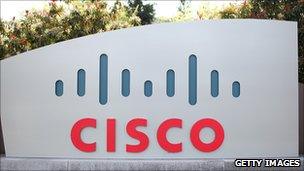Cisco predicts internet device boom
- Published

Cisco expressed its worry at rapid growth in the face of finite capacity
The number of internet connected devices is set to explode in the next four years to over 15 billion - twice the world's population by 2015.
Technology giant Cisco predicts the proliferation of tablets, mobile phones, connected appliances and other smart machines will drive this growth.
The company said consumer video will continue to dominate internet traffic.
It predicts that by 2015, one million minutes of video will be watched online every second.
The predictions come from Cisco's fifth annual forecast of upcoming trends.
Cisco's Visual Networking Index also estimated that at the same time more than 40% of the world's projected population will be online, a total of nearly three billion people.
The networking giant forecast that by 2015 internet traffic will reach 966 exabytes a year.
An exabyte is equal to one quintillion bytes. In 2004, global monthly internet traffic passed one exabyte for the first time.
But Cisco said alongside this quadrupling of traffic comes a number of very real concerns.
"What you are seeing is this massive growth in devices, the way devices are being used and are connected to the internet and what users expect them to do," said Suraj Shetty, Cisco vice president for global marketing.
"All this is putting a lot of pressure on the internet and the next generation internet faces issues handling not just the proliferation of these devices but how they are going to grow and be intelligent enough to be connected to you.
"The most important question we face is how to manage all this traffic intelligently," Mr Shetty added.
'Consumer riot'
Cisco's report underlines a very real problem the internet as a whole faces as it runs out of what is known as internet protocol version 4 or IPv4 addresses.
Every device needs one of these IPv4 addresses to send and receive data online.
When IPv4 was created in 1977, it was thought that its pool of 4.3 billion addresses would be enough to go around.
The rise in the number of mobile devices, laptops and connected machines has helped exhaust that stock.
In February, the Internet Assigned Numbers Authority handed out the last batch of these addresses. Industry experts believe they could be all used up as early as August.
The solution is an alternative addressing standard approved in 1998 called IPv6.
There are trillions of these addresses but persuading companies to move to IPv6 has been a slow process.
"We are running out of IPv4 addresses and the adoption of IPv6 is going to be front and centre of everything for the next several years," Mr Shetty told 成人快手 News.
As we adopt more internet-enabled devices in the home, addresses for each item are quickly running out
"The implication for vendors like Cisco is that we have to come up with a platform that can help scale the internet to handle a lot of the traffic and to do it smartly.
"If you want to keep adding billions and billions of devices, the only answer is IPv6."
On 8 June, on what has been dubbed World IPv6 Day, Cisco will be joined by telecom giant Verizon, Yahoo, Google, Facebook, TimeWarner, Comcast and many others in testing IPv6.
This will allow everyone to check out the compatibility of websites and associated networking technologies with IPv6.
"It is clear that the move to IPv6 will be critical in supporting the total number of devices on the global internet going forward and it will be crucial for service providers and enterprises to start migrating to IPv6," said Ed Horely, co-chair of the California IPv6 task force.
"They need to do this to be able to meet the needs and demands of all the existing devices like cell phones, iPads and PC's but also all the future devices that we will want connected to the internet.
"IPv6 will be critical in avoiding the potential consumer riot due to lack of internet addresses for their portable devices to gain access to the internet and many of the cloud services being deployed today," Mr Horely said.
- Published4 February 2011
- Published28 January 2011